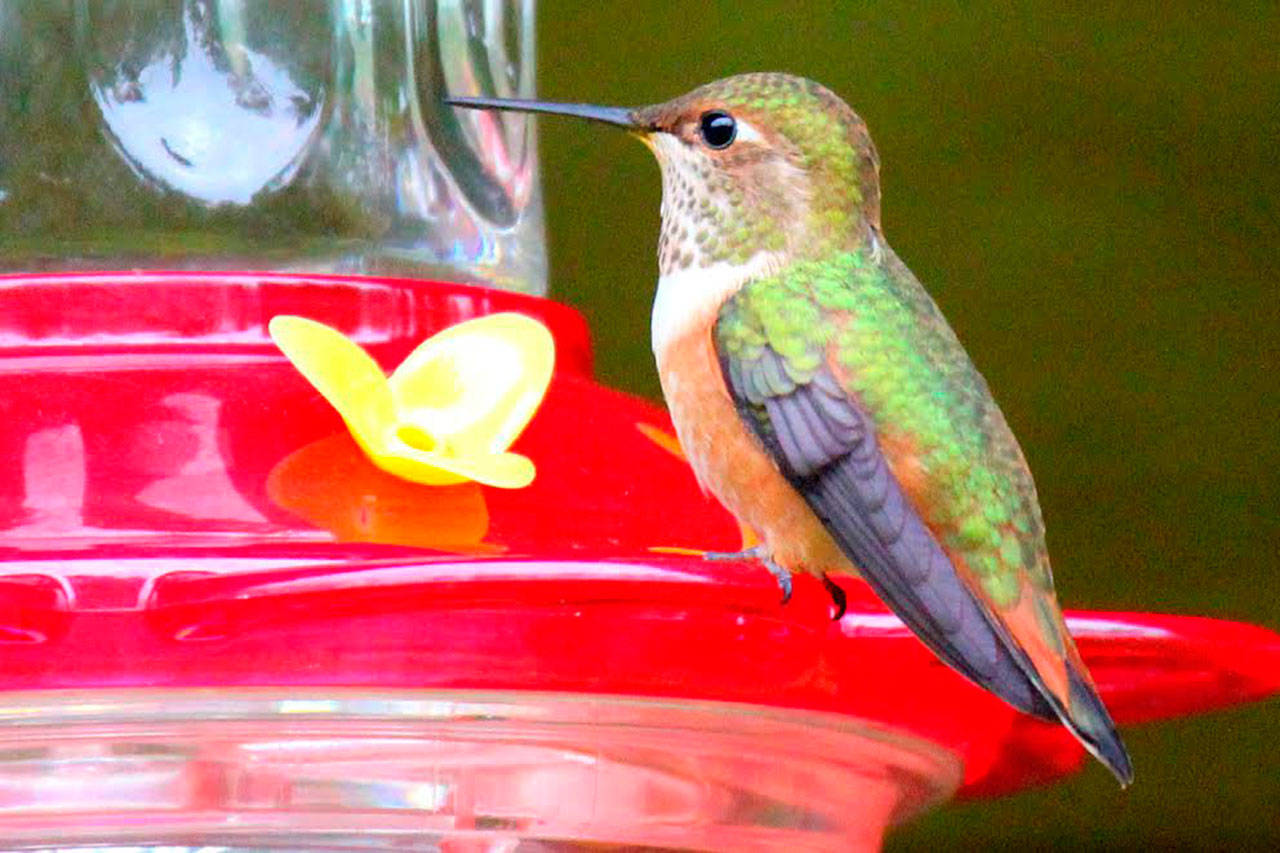As the Pacific Northwest slowly thaws, currants bloom, beckoning the return of the tiny, feisty, orange-red gem-like creatures known as Rufous hummingbirds.
“I’ve already had several sighting reports from very reliable birders,” said Barbara Jensen, president of the San Juan Islands Audubon chapter.
What is a Rufous?
For their body size, approximately three inches long with a four-inch wingspan, Rufous hummingbirds have an incredible migratory route. These pint-sized birds fly as far south as Mexico, and as far north as Alaska, according to Jensen. To put that flight in perspective, that is a distance of roughly 1,957 miles.
Dining off nectar and insects, males arrive a few weeks before the females, usually between the end of February and mid-March. To watch their journey, visit learner.org/jnorth/humm/index.html.
By June, Rufous males fly to higher elevation, either the Cascades or the Rocky Mountains, according to Jensen, where flowers are still blooming. Then, they make their way south again. The females and juveniles make their exodus south toward the end of summer. This leaves the local resident Annas hummingbirds in peace for fall and winter since the Rufous hummingbirds have been known to drive them away from competing food sources and nesting habitat.
Nice neighbors
These long-distance travelers, signalers of spring and all-around little firecrackers have found their way into the hearts of island birdwatchers.
“Many islanders become invested in watching them raise families,” said renowned naturalist Susan Vernon. “We feel we have a stake in their survival.”
Vernon tells the story of some friends who discovered Rufous females were using lint from their dryer as nesting material. They made the collecting process easier by setting bits of lint out in a holder for the lady birds. Rufous females are quite busy, responsible for building the nest and rearing the young, according to Jensen. Incubation of their eggs, Vernon estimates, is about 15 to 17 days, and can take up to another three weeks for the young to fledge or fly.
One recent sighting report to Jensen came from Dick Wright, retired teacher and avid birder, who has been watching Rufous hummingbirds for years. The Wrights have even named one of their frequent visitors.
“We call him Eric the Red,” Dick’s wife Janet Wright said of their Rufous neighbor.
They are fun to watch, Dick said, adding that they are incredibly acrobatic. The Rufous males with their iridescent red caps will dominate feeders, chirpping as they chase the larger Annas hummingbirds away.
“They have had to be feisty, I suspect, defending flowers and nests against much larger hummingbirds,” said Vernon.
In fact, Shakespeare’s “Midsummer Night’s Dream” quote, “Though she be but little, she is fierce,” could very easily be said of the Rufous.
Romance
The “National Audubon Field Guide” states that Rufous are not monogamous, and males often mate with several females.
“Male’s courtship display flight traces a steep U shape or vertical oval, climbing high and then diving steeply with whining and popping sounds. He also buzzes back and forth in front of perched female,” reads the guide. The male then continues on seducing other females. The females, after mating, go off to lay their eggs and raise the young.
The future?
Unfortunately, around the nation, Rufous numbers have been declining, according to Jensen. Global warming is thought to be a contributing factor, but since Rufous are difficult to band due to their small size, there are many questions about these birds and why they may be struggling. Luckily, the islands currently seem to have a solid population.
Immediate threats, according to Shona Aitken, Wolf Hollow Rehabilitation Center’s education coordinator, are cats, unclean feeders that grow bacteria and mold, being trapped inside buildings, or nests destroyed when people clear brush and take down trees during the spring and summer nesting season. Wolf Hollow, Aitken said, receives several Rufous hummingbirds every year, including five rescued in 2016.
Vernon adds pesticides and window collisions to the list of threats. All of these issues are avoidable; clean feeders thoroughly every few days and keep feeders high, away from cats. Cats should be kept inside, at least during daylight hours. If you must use pesticides, don’t spray blooming flowers, and use window decals.
“You don’t have to use a feeder,” Jensen adds, “you can plant native plants like honeysuckle, salvia, or Oregon grape. You can also set up a dripping water station, which will attract all kinds of birds.”
For those who opt to use feeders, keep the ratio to four parts water, one part sugar. Most importantly, Vernon, Jensen, Aitken and Wright say, opt for a feeder that is easy to maintain and keep it clean and fresh. During the summer, this means change it every few days.
“Our task is to ensure that wild places remain intact along their migration route, that currant and other nectar plants they need are available, and that they always have a secure place here to call home,” said Vernon, who is thankful for the hummingbird sightings.
“Aren’t we the luckiest folks alive to be living here among them?” she asked.
To learn more about Rufous hummingbirds and all other local species of birds, visit San Juan Islands Audubon Society, www.sjiaudubon.org.




